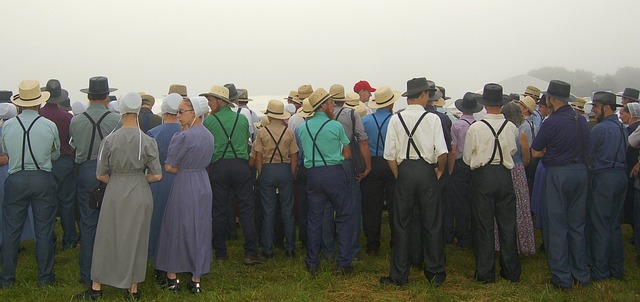The Amish are a religious group that originated in Switzerland in the 16th century. They are known for their simple lifestyle, traditional dress, and rejection of modern technology. While the Amish have roots in German-speaking regions, it is important to note that not all Amish people are of German descent.
Table of Contents
The History and Origins of the Amish in Germany
Are Amish German?
When you think of the Amish, you might picture a community of people living a simple, traditional lifestyle in rural America. But did you know that the roots of the Amish actually trace back to Germany? That’s right, the Amish have their origins in Germany, and their history is a fascinating one.
The story of the Amish begins in the 16th century, during a time of religious upheaval in Europe. In the early 1500s, a group of Christians in Switzerland and southern Germany began to question the practices of the established church. They believed in a more literal interpretation of the Bible and sought to live a life that was closer to the teachings of Jesus.
These Christians, known as Anabaptists, faced persecution for their beliefs. They were seen as radical and were often subjected to imprisonment, torture, and even death. In order to escape this persecution, many Anabaptists fled to neighboring countries, including Germany.
In Germany, the Anabaptists found a more welcoming environment. They settled in rural areas and formed tight-knit communities, where they could practice their faith freely. Over time, these communities developed their own distinct customs and traditions, which would eventually become the foundation of the Amish way of life.
The Amish, as we know them today, emerged in the 18th century. By this time, the Anabaptist communities in Germany had grown and spread to other parts of Europe, including Switzerland and the Netherlands. It was in these countries that the Amish began to take shape as a distinct group.
The Amish were known for their commitment to simplicity, humility, and community. They rejected modern conveniences and technology, choosing instead to live a life that was centered around faith, family, and hard work. They dressed in plain clothing, traveled by horse and buggy, and relied on traditional farming methods.
In the late 17th century, a group of Amish immigrants made their way to America, seeking religious freedom and the opportunity to build a new life. They settled in Pennsylvania, where they established the first Amish communities in the United States. Today, the largest population of Amish can still be found in Pennsylvania, as well as in Ohio, Indiana, and other states.
Despite their German origins, the Amish have developed their own unique dialect of German, known as Pennsylvania Dutch. This dialect is a blend of German, English, and other languages, and is spoken by many Amish communities in the United States.
So, are the Amish German? While their roots can be traced back to Germany, the Amish have evolved into a distinct group with their own customs, traditions, and way of life. They have embraced the American culture while still holding on to their German heritage.
In conclusion, the Amish have a rich history that begins in Germany and continues to this day in the United States. Their story is one of perseverance, faith, and a commitment to living a simple, traditional lifestyle. Whether you see them as German or American, one thing is for certain – the Amish are a fascinating and unique community that continues to capture the imagination of people around the world.
Cultural Similarities and Differences Between the Amish and Germans

Are Amish German?
When you think of the Amish, you might automatically associate them with Germany. After all, their traditional clothing, simple lifestyle, and strong religious beliefs seem to align with what we typically think of as German. But are the Amish actually German? Let’s explore the cultural similarities and differences between the Amish and Germans to find out.
Firstly, it’s important to note that the Amish are not German in the sense that they come from Germany. The Amish actually originated in Switzerland in the 16th century as a result of the Anabaptist movement. However, many Amish people did eventually migrate to Germany before making their way to North America. This migration is one reason why there are cultural similarities between the Amish and Germans.
One of the most obvious cultural similarities is the language. The Amish speak a dialect of German known as Pennsylvania Dutch. This dialect is a mix of German, Swiss German, and English. It’s fascinating to hear the Amish speak Pennsylvania Dutch because it sounds similar to German, but with its own unique twist. So, while the Amish are not German, their language does have German roots.
Another cultural similarity between the Amish and Germans is their love for traditional music. Both cultures have a rich musical heritage that includes folk songs and traditional instruments. The Amish, in particular, are known for their a cappella singing, which is often performed in four-part harmony. This style of singing is reminiscent of German choral music and showcases the shared appreciation for music between the Amish and Germans.
When it comes to food, the Amish and Germans also share some similarities. Both cultures value hearty, homemade meals made from scratch. Traditional Amish dishes like shoofly pie, apple butter, and sauerkraut are reminiscent of German cuisine. The Amish also have a strong tradition of canning and preserving food, just like the Germans. So, if you’re a fan of German food, you might find some similarities in Amish cuisine as well.
Despite these cultural similarities, there are also some notable differences between the Amish and Germans. One of the biggest differences is their religious beliefs. While both cultures are predominantly Christian, the Amish have a more conservative and strict interpretation of Christianity. They emphasize separation from the modern world and live a simple, agrarian lifestyle. Germans, on the other hand, have a more diverse range of religious beliefs and practices.
Another difference is the level of technology embraced by each culture. The Amish are known for their rejection of modern technology, preferring to live without electricity, cars, and other modern conveniences. Germans, on the other hand, are known for their technological advancements and innovation. This stark contrast in attitudes towards technology highlights the different priorities and values of the Amish and Germans.
In conclusion, while the Amish are not German in the sense that they come from Germany, there are certainly cultural similarities between the two. The Amish language, music, and food all have German influences. However, there are also notable differences in religious beliefs and attitudes towards technology. So, while the Amish may not be German, they have certainly been influenced by German culture throughout their history.
Language and Dialects Spoken by the Amish in Germany
Are Amish German?
When we think of the Amish, we often associate them with Pennsylvania Dutch, a dialect of German. But did you know that the Amish in Germany also speak a dialect of German? That’s right! The Amish in Germany have their own unique language and dialects that have been passed down through generations.
The Amish in Germany primarily speak a dialect known as Pennsylvania German, or Pennsilfaanisch Deitsch. This dialect is a variation of the Palatine German dialect, which was spoken by the early German immigrants who settled in Pennsylvania in the 18th century. Over time, this dialect evolved and became distinct from the standard German spoken in Germany.
Pennsylvania German is a fascinating language that combines elements of German, English, and Dutch. It is often referred to as “Dutch” by the Amish themselves, which can be confusing for those unfamiliar with the dialect. However, it is important to note that Pennsylvania Dutch is not the same as the Dutch language spoken in the Netherlands. The term “Dutch” is actually a misnomer, as it is derived from the word “Deutsch,” which means German in German.
The Amish in Germany also speak a variety of other dialects, depending on the region they live in. These dialects include Hessian, Swabian, and Low German. Each dialect has its own unique characteristics and pronunciation, making it distinct from the others. Despite these differences, all of these dialects are rooted in the German language and share many similarities.
One interesting aspect of the Amish dialects in Germany is the use of archaic words and phrases. These words and phrases have been preserved over the years and are not commonly used in modern German. This gives the Amish dialects a sense of timelessness and connects them to their ancestors who first settled in Germany centuries ago.
The Amish in Germany also have their own unique vocabulary related to their way of life. For example, they have specific words for various aspects of farming, such as plowing, planting, and harvesting. They also have words for different types of tools and equipment used in their daily lives. This specialized vocabulary reflects the importance of agriculture in Amish culture and their close connection to the land.
Despite the differences in dialects, the Amish in Germany can still understand each other and communicate effectively. This is due to the shared roots of their dialects and the close-knit nature of their communities. The Amish place a strong emphasis on preserving their language and passing it down to future generations. They believe that language is an important part of their cultural identity and helps to maintain their distinct way of life.
In conclusion, the Amish in Germany speak a variety of dialects, including Pennsylvania German, Hessian, Swabian, and Low German. These dialects have evolved over time and have their own unique characteristics and vocabulary. Despite the differences, they are all rooted in the German language and connect the Amish to their ancestors. Language plays a crucial role in Amish culture, helping to preserve their traditions and way of life. So, the next time you think of the Amish, remember that they are not only German, but they also have their own unique language and dialects that set them apart.
Traditional Amish Practices and Customs in German Communities
Are Amish German?
When you think of the Amish, you might picture a group of people living a simple, traditional lifestyle in rural America. But did you know that the Amish actually have their roots in Germany? That’s right, the Amish are descendants of German immigrants who settled in Pennsylvania in the 18th century. Today, there are still Amish communities in Germany, where they continue to practice their traditional customs and way of life.
One of the most fascinating aspects of the Amish culture is their commitment to preserving their German heritage. Despite living in America for generations, the Amish have managed to maintain their German language, which is still spoken in their communities today. This is a testament to their strong sense of identity and their desire to pass down their traditions to future generations.
In addition to their language, the Amish also hold on to many other traditional German customs. For example, they continue to wear traditional German clothing, which consists of plain, modest attire. Men typically wear dark-colored suits with suspenders, while women wear long dresses and bonnets. This distinctive clothing not only reflects their German heritage but also serves as a symbol of their commitment to simplicity and humility.
Another important aspect of Amish culture is their strong emphasis on community and family. In German communities, the Amish live in close-knit groups, often referred to as “church districts.” These districts are made up of several families who live and work together, supporting one another in their daily lives. This sense of community is deeply rooted in their German heritage, where the concept of “Gemeinschaft” (community) is highly valued.
One of the most well-known Amish traditions is their rejection of modern technology. This practice, known as “Ordnung,” is deeply rooted in their German heritage and reflects their desire to live a simple, self-sufficient lifestyle. In German communities, you won’t find cars or electricity. Instead, the Amish rely on horse-drawn buggies for transportation and use oil lamps for lighting. This commitment to simplicity and self-sufficiency is a direct reflection of their German roots and their desire to live in harmony with nature.
Despite their strong ties to Germany, the Amish have also adapted to their surroundings in America. Over the years, they have incorporated some American customs into their way of life while still maintaining their German traditions. For example, many Amish communities celebrate American holidays such as Thanksgiving and the Fourth of July, while still adhering to their own religious practices and customs.
In conclusion, while the Amish may live in America, their German heritage is deeply ingrained in their culture and way of life. From their language to their clothing and customs, the Amish continue to honor their German roots and pass down their traditions from one generation to the next. So, the next time you see a group of Amish people, remember that they are not only American but also proudly German.
Conclusion
Yes, the Amish are of German descent.



